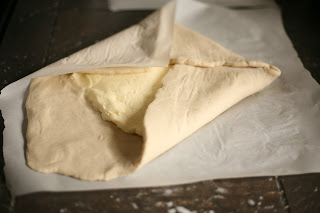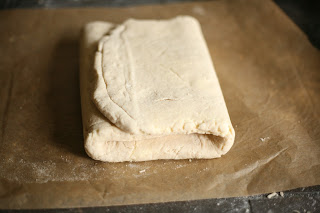How to Laminate Dough for Puff Pastry, Croissants, and Danishes
I used to say that the only things I missed about eating gluten were croissants and beer. Those of you that follow my Facebook page know that I've been working really hard to perfect a recipe for croissants. My next post will be about making the croissant dough. This post will be about the technique for laminating dough for puff pastry, croissants and danishes. The three types of dough are a little different from each other, but the technique to incorporate the butter into the dough is the same for all three recipes.
You will need:
Ingredients
1 recipe puff pastry, croissant, or danish dough.
chilled butter for the recipe, usually 12 oz/3sticks/340 grams
2 Tbsp GF flour or starch of your choice
potato starch for dusting the dough
Equipment
parchment paper or, less desirable, plastic wrap
rolling pin, preferably a club-style pin but I use a marble rolling pin
A dry, clean pastry brush
I drew heavily from Joe Pastry's blog post about this same technique. He makes his pastries with wheat-based flour, so there will be a few minor differences, but his page is a good reference.
The photos are all taken of my croissant dough.
The dough has chilled a bit, and now you want to encase the butter in it for rolling out into many layers. The first step is to make your butter packet. Take your sticks of butter and place them on some parchment paper. Sprinkle 1 Tbsp of the flour on top. Flip all the butter over and sprinkle the other tablespoon of flour on the other side. Start pounding the butter. Pound it hard. You should be making some noise. If the butter isn't denting at all, let it warm up for a few minutes and try again. Conversely, if at any point the butter starts looking shiny you should put it in the fridge to chill. Pound the butter until all the flour is incorporated and the butter is malleable. Fold the butter onto itself a and pound it into a rough square about 8 inches wide. Put the butter packet in the refrigerator for a few minutes while you roll out the dough.
Take your dough out of the refrigerator. Dust your hands with potato starch and sprinkle some starch onto the top of the dough. Turn the dough out onto a smooth surface floured with starch and put some starch on the bottom of the dough as well. Brush the starch over the whole surface of the dough and form the dough into a ball. The dough should feel very manageable with the starch coating it. Knead it a few times and re-coat with starch. If it's not manageable with a good starch coating, you may need to knead more pastry flour or starch into the dough.
Place the dough ball on a large sheet of parchment paper. Press it down into a disk and re-coat with starch if needed. Roll it out into a square about 12 inches on each side. To make straight edges, create a mold with the parchment paper and roll it out to the edges, like this:
Place the butter packet into the middle of the dough square making a diamond shape to the dough's square shape, like this:
The butter packet can be a little bigger than this and still be folded in okay. Don't fuss with making it perfect - just work quickly to avoid everything getting too warm. Fold the corners of the dough over the butter to meet in the middle, using the parchment paper to support it during the fold if necessary.
Pinch the dough together on the seams to seal the butter in completely. Push the corners and sides up against the butter packet and make sure none of the butter breaks through or shows.
Dust the top with starch and flip the whole dough packet over onto the center of the parchment paper. Dust the bottom side, which should be pretty smooth. Press the dough with the rolling pin several times to get the butter spread out to the edges inside the dough.
Roll the dough out into a rectangle that is about twice as long as it is wide. Brush off any excess starch with a pastry brush. Try to make the rectangle as uniform as possible, with even distribution of dough. (This dough rectangle could do better.)
Fold the dough into the type of fold your recipe calls for, brushing off excess starch as you go. (Too much starch on the surface of the dough can make it dry or tough.) If cracks form in the fold pinch them back together.
A letter fold is folded like a business letter. Cut the inside edge to show the layers of butter and make a clean edge. Fold the dough in a tri-fold.
A book fold is a double fold, also called a wallet fold. Cut the rough edges off both ends. You fold the sides in toward the center, leaving a gap between. Then you fold the two sides together like a wallet.
Turn the dough so you are rolling it out toward the open ends.
You can usually get away with rolling it out once more before refrigerating. Use your judgement. If it's too soft, refrigerate it for 20 minutes first. Do your second press, roll, fold and turn and refrigerate for 20 minutes, then do your third. Always end on a book fold because it gives you a neater package of dough with nice square corners. Rest the dough in the refrigerator for at least 2 hours before rolling it out for your pastry.
You will need:
Ingredients
1 recipe puff pastry, croissant, or danish dough.
chilled butter for the recipe, usually 12 oz/3sticks/340 grams
2 Tbsp GF flour or starch of your choice
potato starch for dusting the dough
Equipment
parchment paper or, less desirable, plastic wrap
rolling pin, preferably a club-style pin but I use a marble rolling pin
A dry, clean pastry brush
I drew heavily from Joe Pastry's blog post about this same technique. He makes his pastries with wheat-based flour, so there will be a few minor differences, but his page is a good reference.
The photos are all taken of my croissant dough.
The dough has chilled a bit, and now you want to encase the butter in it for rolling out into many layers. The first step is to make your butter packet. Take your sticks of butter and place them on some parchment paper. Sprinkle 1 Tbsp of the flour on top. Flip all the butter over and sprinkle the other tablespoon of flour on the other side. Start pounding the butter. Pound it hard. You should be making some noise. If the butter isn't denting at all, let it warm up for a few minutes and try again. Conversely, if at any point the butter starts looking shiny you should put it in the fridge to chill. Pound the butter until all the flour is incorporated and the butter is malleable. Fold the butter onto itself a and pound it into a rough square about 8 inches wide. Put the butter packet in the refrigerator for a few minutes while you roll out the dough.
Take your dough out of the refrigerator. Dust your hands with potato starch and sprinkle some starch onto the top of the dough. Turn the dough out onto a smooth surface floured with starch and put some starch on the bottom of the dough as well. Brush the starch over the whole surface of the dough and form the dough into a ball. The dough should feel very manageable with the starch coating it. Knead it a few times and re-coat with starch. If it's not manageable with a good starch coating, you may need to knead more pastry flour or starch into the dough.
Place the dough ball on a large sheet of parchment paper. Press it down into a disk and re-coat with starch if needed. Roll it out into a square about 12 inches on each side. To make straight edges, create a mold with the parchment paper and roll it out to the edges, like this:
Place the butter packet into the middle of the dough square making a diamond shape to the dough's square shape, like this:
The butter packet can be a little bigger than this and still be folded in okay. Don't fuss with making it perfect - just work quickly to avoid everything getting too warm. Fold the corners of the dough over the butter to meet in the middle, using the parchment paper to support it during the fold if necessary.
Pinch the dough together on the seams to seal the butter in completely. Push the corners and sides up against the butter packet and make sure none of the butter breaks through or shows.
Dust the top with starch and flip the whole dough packet over onto the center of the parchment paper. Dust the bottom side, which should be pretty smooth. Press the dough with the rolling pin several times to get the butter spread out to the edges inside the dough.
Roll the dough out into a rectangle that is about twice as long as it is wide. Brush off any excess starch with a pastry brush. Try to make the rectangle as uniform as possible, with even distribution of dough. (This dough rectangle could do better.)
Fold the dough into the type of fold your recipe calls for, brushing off excess starch as you go. (Too much starch on the surface of the dough can make it dry or tough.) If cracks form in the fold pinch them back together.
A letter fold is folded like a business letter. Cut the inside edge to show the layers of butter and make a clean edge. Fold the dough in a tri-fold.
A book fold is a double fold, also called a wallet fold. Cut the rough edges off both ends. You fold the sides in toward the center, leaving a gap between. Then you fold the two sides together like a wallet.
You can usually get away with rolling it out once more before refrigerating. Use your judgement. If it's too soft, refrigerate it for 20 minutes first. Do your second press, roll, fold and turn and refrigerate for 20 minutes, then do your third. Always end on a book fold because it gives you a neater package of dough with nice square corners. Rest the dough in the refrigerator for at least 2 hours before rolling it out for your pastry.













Comments